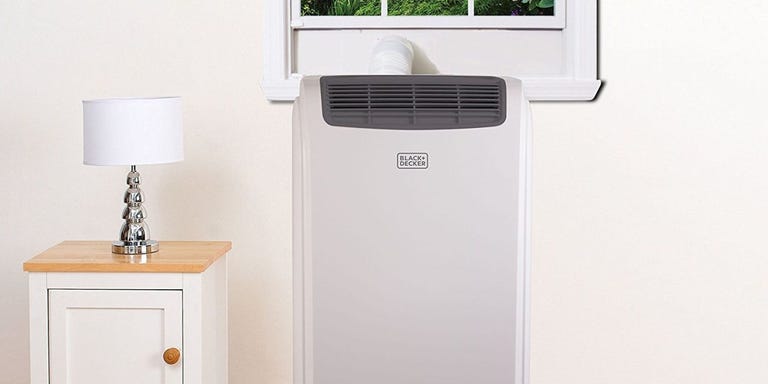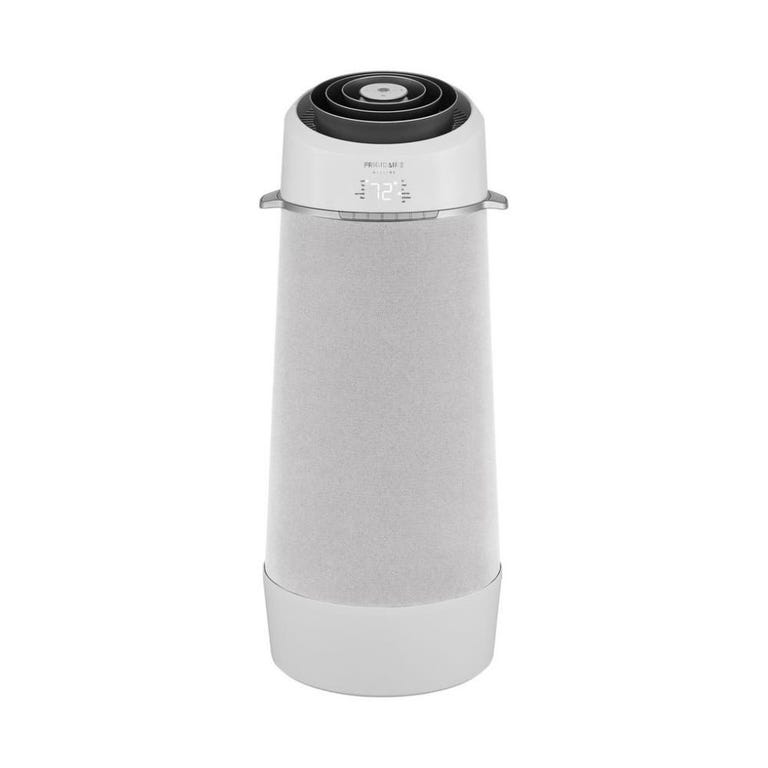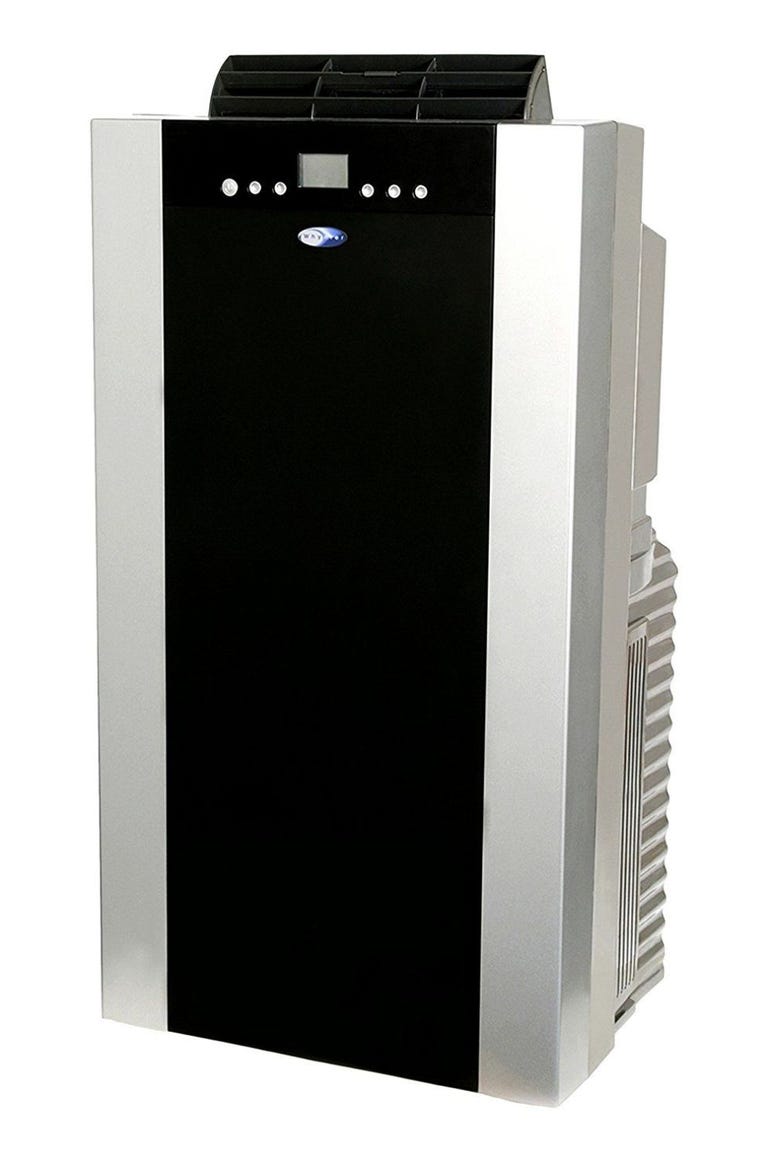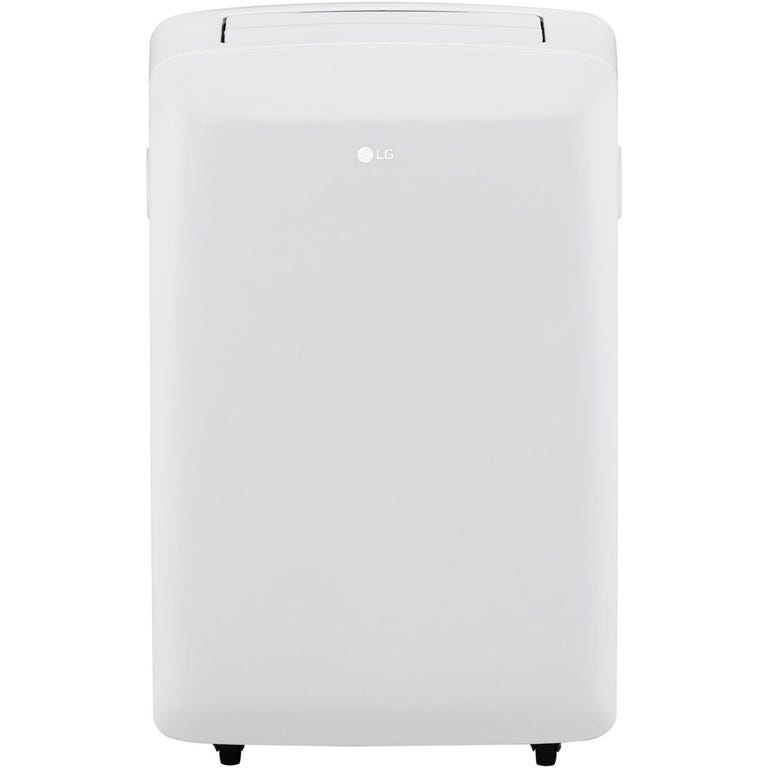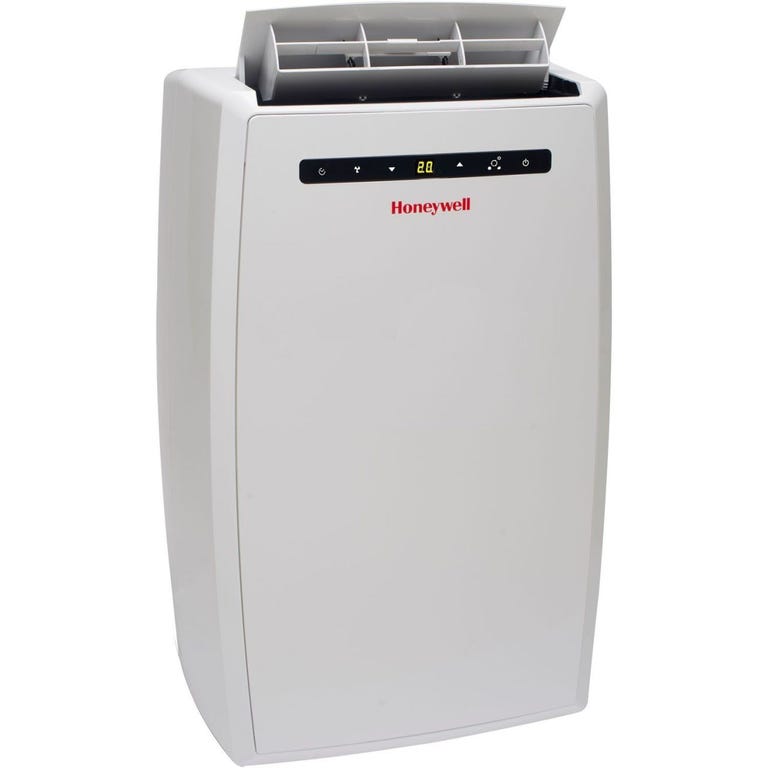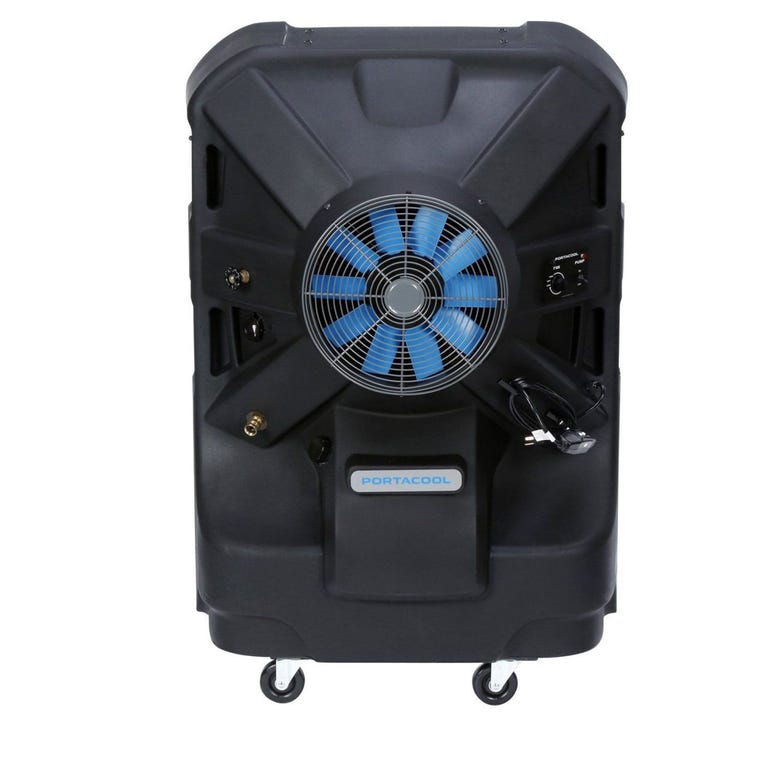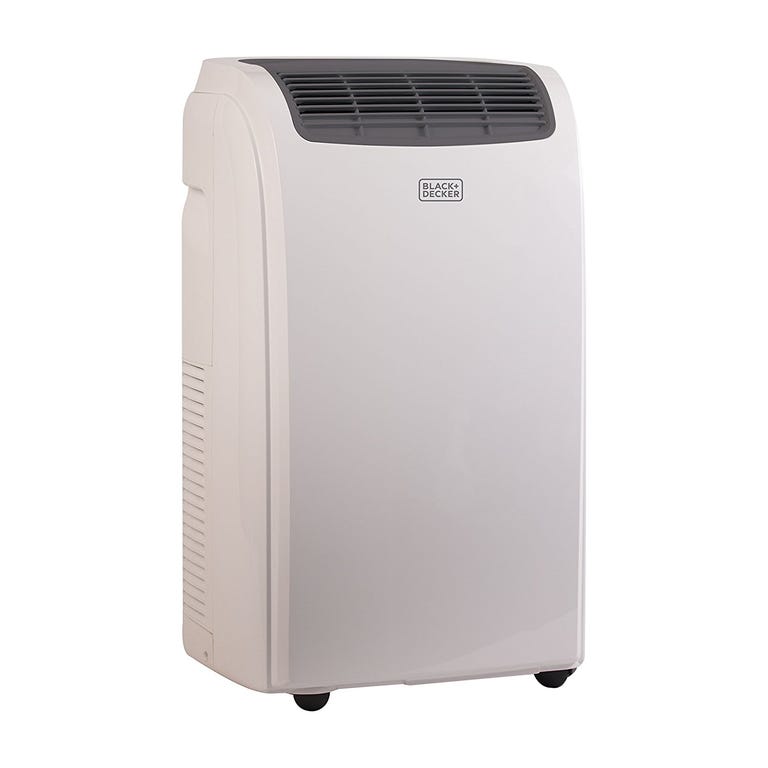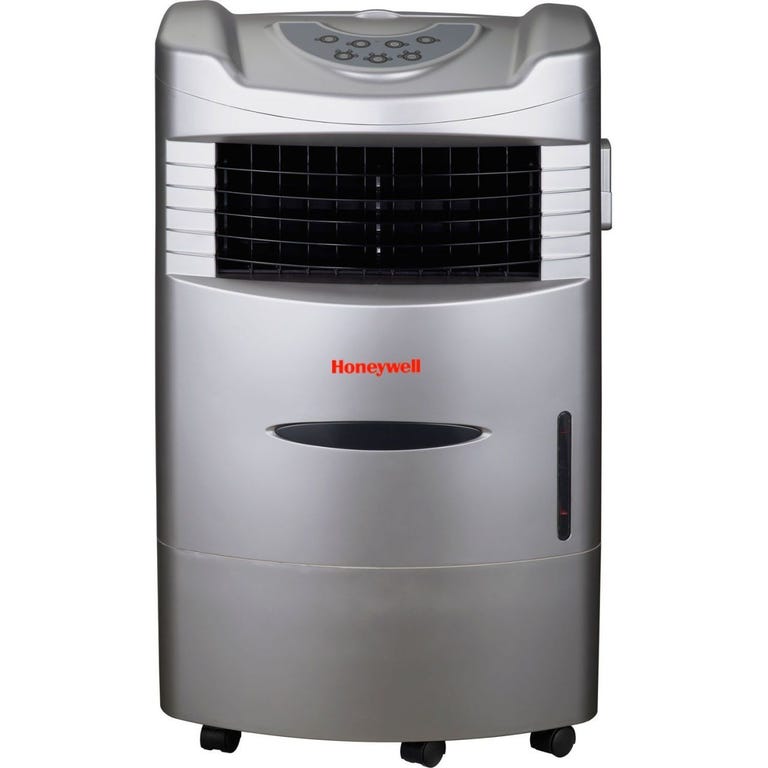Posted on
July 27, 2018
by
Fabrizio Zenone
If your home lacks central air conditioning, you don't have to settle for using fans or window-mounted ACs to keep you cool. These portable air-conditioners can be moved from room to room, but require the use of an exhaust hose that is typically vented through a window. The last two on the list are evaporative coolers that do not use a compressor or require a venting hose, but they are most effective in hot dry climates and with room windows open.
Best Tech: Frigidaire Smart Portable Air Conditioner
This big Frigidaire just might be the smartest piece of tech in your home. You can remotely turn the unit on or off, change temperature, and control mode and fan speeds. This all adds up to saving energy. The A/C unit will remind you when the filter needs to be changed and about any other maintenance it needs. It's rated to cool a room up to 550 square feet.
Best Value: Honeywell Compact Cooler and Humidifier
This portable AC unit from Honeywell packs a ton of features into a value-priced product. In addition to serving as an air-conditioner, it can also be used as a fan and humidifier. Other features include low energy, carbon dust filter, and a remote control. It's available in five sizes, from 176 to 525 CFM.
High Performance: Whynter Eco-Friendly Air Conditioner
This 3-in-1 portable A/C operates as a air-conditioner, fan, and dehumidifier. Its dual hose exhausts and drains all condensate,
which allows the unit to perform at its peak. It rolls on casters and can be used in computer/server rooms, bedrooms,
classrooms, and garages/workshops.
Best Design: LG Portable Air Conditioner
This all-white sleek portable AC looks great in any room. The auto-swing air vent circulates the cool air more efficiently,
which lessens hot spots in a room. The auto evaporation system allows for continuous use, and like most other portable
A/C units, it includes a programmable 24-hour on/off timer, which monitors and controls the temperature while you are away.
Most Versatile: Honeywell Portable Air Conditioner
The Honeywell can cool and dehumidify areas up to 350-400 square feet. It includes a full-function remote control allows
you to operate each feature from across the room. The auto-evaporation system allows for hours of continuous operation,
with no water to drain or no bucket to empty. Included is a flexible exhaust hose and window venting kit, which can be
removed when the A/C unit is not in use.
Best for Large Spaces: Portacool Jetstream
When you need serious cooling power for working on home improvement projects or in your garage, the Portacool
Jetstream evaporative cooler is one of the largest portable coolers you'll find. It can cool garages and shop spaces
up to 1,125 square feet, as well as provide a welcome breeze of 4,500 CFM to patios and decks. Connect your garden
hose and fill up the 50 gallon tank, then fire up the pump and fan and you are ready to go. Bonus: It's made in the USA.
Easy Mobility: Black + Decker Portable Air Conditioner
Black+Decker is more than just tools. They now make a lot of household products including portable air conditioners.
This full-featured air conditioner is one of the lightest available, and rolls easily on casters with handles for transport.
Most Compact: Honeywell Portable Evaporative Cooler
This little unit packs a chilly punch that can cool a room up to 280 square feet. Evaporative coolers like this one are most
effective in dry conditions and draw less electricity than typical air conditioners. Fill the top-loading ice compartment plus
5.3-gallon (42-pint) water tank, open your windows and doors, and enjoy the cool breeze.
Best Remote: Hisense Portable Air Conditioner
This unit from Hisense can be controlled via an included remote, or your smart phone, which allows you to cool the room
before you arrive or turn it off while you are away. It runs quiet and the cross-flow fan design cools a room quickly. The
included window ventilation kit installs quickly in horizontal or vertical windows from 18 to 50-inch wide openings.
Posted on
July 27, 2018
by
Fabrizio Zenone

The housing market, like most markets, is cyclical. These cycles can be greatly influenced by a number of factors, including interest rates, economic conditions and consumer confidence, which can create a shortage or surplus in housing. A seller’s market happens when there’s a shortage in housing or more potential buyers than homes. A buyer’s market, on the other hand, occurs when there is a surplus in housing or more homes for sale than buyers. A balanced market happens when there is the same number of homes for sale as there are buyers.
Seller’s market at-a-glance
- More buyers than homes for sale
- Prices tend to be higher because of increased demand
- Homes sell quickly
- More likely to be multiple offers on a home, which gives sellers negotiating power (and conditional offers may be rejected)
Buyer’s market at-a-glance
- More homes on the market than buyers
- Prices tend to be lower because of increased supply
- Homes are more likely to sit unsold
- Housing surplus can slow rising prices and even lead to price reductions
- Buyers have more choices and more leverage to negotiate
If you’re looking to buy (or sell) a home, it’s important to know which type of market you’re entering into. If you’re unsure, ask your real estate agent. Of course, selling a home in a seller’s market is optimal, as is buying a property in a buyer’s market. But people don’t necessarily have the luxury of timing their home sale or purchase to coincide with the most advantageous market. It could be quite likely, for instance, that you’d be buying in a seller’s market or selling in a buyer’s market.
Tips on selling your home in different housing markets
Selling in a seller’s market is generally quick and easy. In a buyer’s market, with an abundance of properties sitting idle, you may want to do some legwork to help sell your home. There are a number of things you can do to improve your chances for making a sale. These include:
- Understand the local market and your competition
- Price your home right (and conservatively)
- Make sure your home is ready to be shown at all times (consider using a professional home stager who can help show off the best features of every room in your house)
- Be accommodating to your real estate agent's/prospective buyer’s schedules (think of every showing as the one that could get you the sale)
- Be flexible with your terms (offer an extended closing date or lower your asking price)
- Be patient (and stay positive)
- If you get an offer early on, give it serious consideration because a better offer may not come along
Multiple offers
In a seller’s market, with fewer homes available to purchase and more buyers looking, you’re more likely to get several offers on your home. Here are some things you can do to help increase your likelihood for getting multiple offers:
- Keep your home clean, clutter-free, presentable and ready to show (hire a professional stager if you can – see above)
- Consider pricing your home slightly below its fair market value
- Work with your real estate agent to to ensure that your home has sufficient market exposure (i.e. list on REALTOR.ca), create print materials, such as flyers or postcards with key selling points and a professional quality photo of your home, post on social media, consider newspaper/magazine ads, list on other real estate listing web sites and your agency’s company web site)
- Be ready to show your house on demand (with no appointment necessary)
Tips on buying a home in different housing markets
With more homes for sale than buyers and potentially lower prices, a buyer’s market could be a great time to buy a new home. Before doing so, however, consider the possibility that home prices could continue to fall, meaning your new purchase might be worth less than you paid for it in no time. Of course, what goes down may eventually come back up. Still, if you wait for prices to drop even further, you might miss out on a great opportunity.
If you’re looking to buy in a difficult seller’s market, there are things you can do to improve your likelihood for success.
- Get pre-approved for a mortgage first, so you know how much home you can afford
- Put forward a strong offer with a significant deposit amount
- Move quickly on a home if you like it (and be aggressive without being annoying)
- Make your offer as attractive and uncomplicated as possible (i.e. eliminate as many contingencies as possible, such as a contingency on sale of your existing property, shorten the closing date or come up with a larger down payment)
- Be agreeable and responsive
- Be flexible with your move-in date
- Appeal to the seller with a personal letter
Bidding wars
If you should find yourself in a bidding war with another potential buyer, try to not show your hand to them or the seller. Instead, try to figure out the seller’s trigger—such as a specific closing date that would work for them—and include that in your offer. This could potentially give you an advantage over other offers. Also, keep in mind that sellers prefer offers that have no conditions attached.
Posted on
July 4, 2018
by
fabrizio zenone
With home sale activity dipping below long-term historical averages, the supply of homes for sale in Metro Vancouver* reached a three-year high in June.
The Real Estate Board of Greater Vancouver (REBGV) reports that residential home sales in the region totalled 2,425 in June 2018, a 37.7 per cent decline from the 3,893 sales recorded in June 2017, and a 14.4 per cent decrease compared to May 2018 when 2,833 homes sold.
Last month’s sales were 28.7 per cent below the 10-year June sales average.
“Buyers are less active today. This is allowing the supply of homes for sale to accumulate to levels we haven’t seen in the last few years,” Phil Moore, REBGV president said. “Rising interest rates, high prices and more restrictive mortgage requirements are among the factors dampening home buyer activity today.”
There were 5,279 detached, attached and apartment properties newly listed for sale on the Multiple Listing Service® (MLS®) in Metro Vancouver in June 2018. This represents a 7.7 per cent decrease compared to the 5,721 homes listed in June 2017 and a 17.2 per cent decrease compared to May 2018 when 6,375 homes were listed.
The total number of homes currently listed for sale on the MLS® system in Metro Vancouver is 11,947, a 40.3 per cent increase compared to June 2017 (8,515) and a 5.8 per cent increase compared to May 2018 (11,292). This is the highest this total has been since June 2015.
“With reduced demand, detached homes are entering a buyers’ market and price growth in our townhome and apartment markets is showing signs of decelerating.”
For all property types, the sales-to-active listings ratio for June 2018 is 20.3 per cent. By property type, the ratio is 11.7 per cent for detached homes, 24.9 per cent for townhomes, and 33.4 per cent for condominiums.
Generally, analysts say that downward pressure on home prices occurs when the ratio dips below the 12 per cent mark for a sustained period, while home prices often experience upward pressure when it surpasses 20 per cent over several months.
The MLS® Home Price Index composite benchmark price for all residential properties in Metro Vancouver is currently $1,093,600. This represents a 9.5 per cent increase over June 2017 and is virtually unchanged from May 2018.
Sales of detached homes in June 2018 reached 766, a 42 per cent decrease from the 1,320 detached sales recorded in June 2017. The benchmark price for a detached home is $1,598,200. This represents a 0.7 per cent increase from June 2017 and a 0.6 per cent decrease compared to May 2018.
Sales of apartment homes reached 1,240 in June 2018, a 34.9 per cent decrease compared to the 1,905 sales in June 2017. The benchmark price for an apartment is $704,200. This represents a 17.2 per cent increase from June 2017 and a 0.4 per cent increase compared to May 2018.
Attached home sales in June 2018 totalled 419, a 37.3 per cent decrease compared to the 668 sales in June 2017. The benchmark price of an attached home is $859,800. This represents a 15.3 per cent increase from June 2017 and is virtually unchanged from May 2018.
Posted on
July 4, 2018
by
ROSA ZENONE
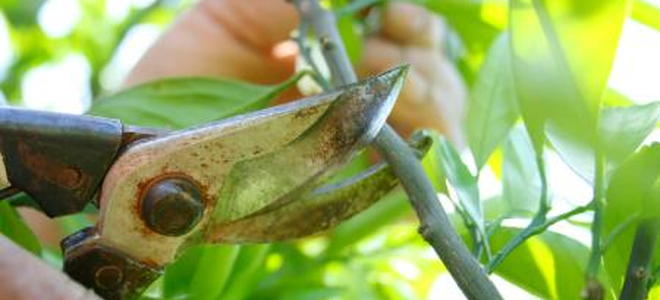
Tree pruning can be a difficult concept for many growers, but proper pruning is essential to proper growth and fruit development. When it comes to pruning, it seems like an arcane a mixture of art and science. When my dad bought his first fruit tree, he tried pruning by himself. His idea was that pruning was more for looks than anything else. He’d take the time to cut them into a nice shape and take off any dead or dying branches. He’d also do it about once a month. He was also doing it all wrong.
Pruning is far more than just a cosmetic treatment for your fruit trees; it’s a necessary part of growing process. Improperly pruned trees can end up overloaded with fruit or bear no fruit at all.
(For more info on growing your trees, look here.)
When Do You Prune?
Any cutting of dead branches and shaping done throughout the year is more akin to cleaning. Pruning is specifically designed to make it easier for the tree to grow and bear fruit. The primary time to prune a tree is at the tail of winter, at the end of the tree’s dormant cycle, or very early in spring. There are no leaves or fruit to bar your way and you have a clear vantage of the branches. There’s nothing worse than trying to cut a tree branch and end up falling off your ladder, cutting through a branch or being hit in the head by falling fruit. (Been there, done that). The other time to prune is during the summer, but that's only to time down trees that are over grown or too big.
Pruning a Young Tree
Young trees need to be pruned heavy. You basically turn small trees back into sticks in the ground. You’ll want to keep any small horizontal branches and get rid of any that are growing more vertically or downward below 90 degrees. Ideally, you want branches that are shooting for 45 to 60 degrees. Of course, any damaged or diseased branches have to go, as well as any small trees sprouting at the base. These are called suckers and compete for nutrients and do nothing for you.
Pruning a Larger Tree
When trees get larger, consider topping and thinning. Be careful of topping versus thinning trees. Topping a tree means cutting the tops of the tree into a snowball or flattop shape. This is drastic, and I always leave this to a professional arborist. If done wrong, topping can severely decrease the foliage of the tree as well as create several new shoots going off in all different directions. Topping is usually only done if the tree is so large that it could cause damage to property or if it is near power lines. Thinning means complete removal of the branches back to the main stem. You can keep the overall shape of the tree and new growth is distributed via numerous areas. You also want to cut off any branches that have turned and are growing towards the tree.
Buds Versus Branches
Trimming buds should be done right where the bud and tree connect. You don’t want to leave any stubs. You want to prune buds and shoots if branches become too overgrown or too heavy with fruit. Remember, each bud will become a small branch. The old way of pruning branches was to do it flush with the trunk of the tree. The problem was this wound allowed organisms to enter and infect the tree. The accepted way now is to prune just outside where the collar is. This creates a circular wound as compared to oval if cut to close to the main trunk.
My dad never did get the hang of pruning, but that’s no reason why you can’t become an expert.
|
